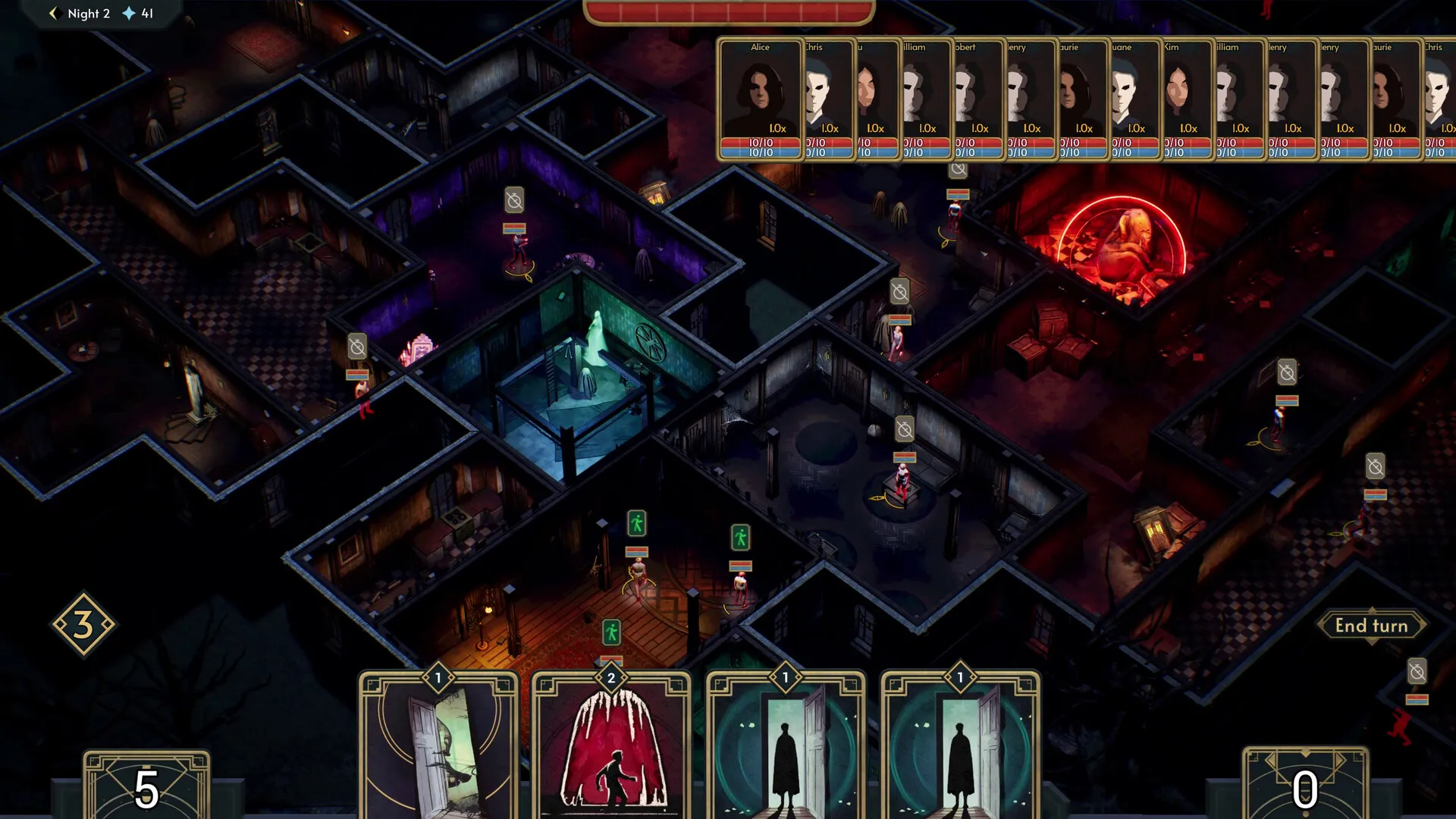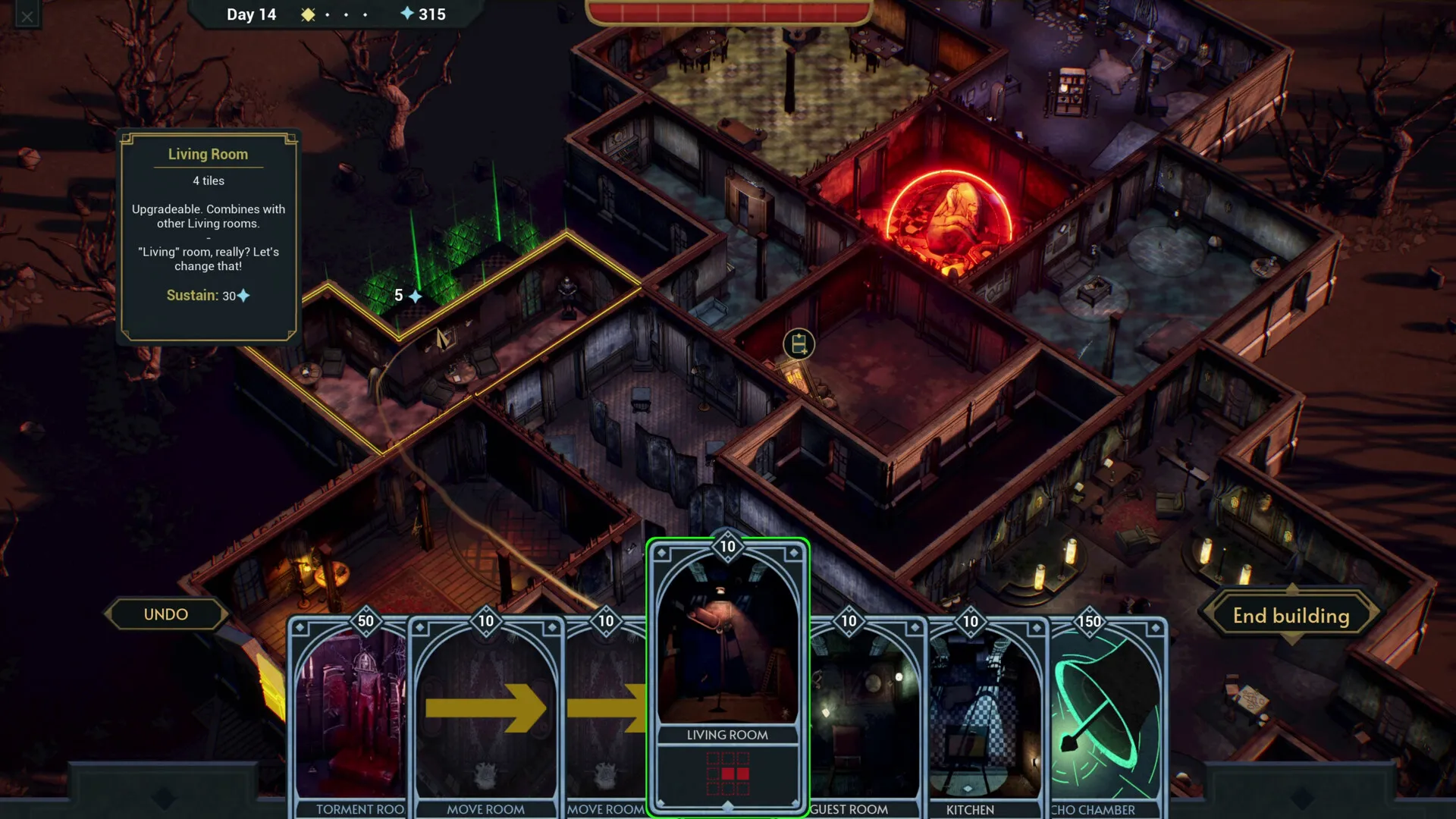In Deck of Haunts, you become a living mansion with one aim: survive 28 nights by thwarting trespassers who seek your heart. Each night, a handful of unwitting explorers—students, clergy, police—shuffle through your corridors, their life and sanity bars ticking down under your spectral influence. By playing cards that wound flesh or fray nerves, you siphon essence to fortify your defenses.
This turn-based roguelike deckbuilder intertwines strategic card play with spatial puzzle elements. You’ll draft cards that teleport, trap or terrify, while rearranging rooms by day to craft a labyrinthine gauntlet. That reverse-horror hook—playing as predator rather than victim—fuels every decision, from choosing a blood-soaked slash to amplifying fear until minds snap.
The core cycle is simple yet compelling: draw a hand, unleash horrors during the night, bank essence, then upgrade either your deck or your haunted layout by day. Early runs focus on basic damage and sanity drains; later, you unlock tension amplifiers, hexes and specialized rooms. Amidst creeping fog and ominous whispers, a darkly playful tone emerges, balancing macabre thrill with wry humor.
Moving the Madness: Core Gameplay Mechanics & Loop
Each night grants three action points to play cards and move intruders. Visitors advance room by room toward your heart; missteps can be punished with a teleport card or a shifting hallway, sending them back into your gloom. Effective blocking tactics let you herd multiple targets into traps or isolated chambers.
Intruders carry two bars: life and sanity. Damage cards thin the flesh, grant 30 essence per kill but leave corpses that can trigger panic or stronger waves. Sanity drains grant 25 essence with no corpse, yet require combo setups for maximum effect. Deciding whether to stun-kill or drive someone insane hinges on your deck’s mix and the intruder’s vulnerability.
A typical loop begins at dusk: draw a hand, choose targets, then see who reaches your heart. At dawn, essence tallies; you must choose between adding a new card or upgrading a room. Then you reconfigure the mansion’s blueprint—adding choke points, pruning corridors or bolstering key chambers—before darkness falls again. The tension between expanding your deck and redesigning your layout drives most strategic dilemmas.
Crafting Fear: Deckbuilding, House Development & Progression
Deck of Haunts offers Damage, Drain, Tension, Hex and Room cards. Damage slashes flesh; Drain erodes sanity. Tension cards seed fear, boosting subsequent effects. Hexes bind intruders, while Room cards add permanent environmental traps. Synergies emerge when you pile on tension before a drain, melting sanity bars in a single blow.
Essence is your currency for both card additions and architectural growth. Some nights, you’ll hoard essence to unlock a powerful hex; others, you’ll spend aggressively to plug a newfound vulnerability in your layout. Resource scarcity intensifies when you’re low on kills or your sanity-build strategies backfire.
Specialty rooms—like the Blood Spigot chamber that auto-damages visitors, or the Whispering Gallery that stacks tension—should be placed at bottlenecks. You’ll create winding corridors and dead ends to trap intruders, or funnel them toward high-damage zones. Crafting shortcuts can sometimes lure multiple targets into a single trap card.
Over successive runs, new cards and rooms surface, and enemy types escalate: novices yield to armed officers, holy men immune to crowd scares, then Masons who shrug off corpses. Managing your heart’s health between nights adds another layer: sometimes you must sacrifice essence for a minor heal, delaying growth but preventing a game-ending breach.
Eerie Ambiance & Technical Performance
The mansion’s pixel art exudes gothic charm—flickering candles, creeping vines on wallpaper—and card illustrations brim with grisly detail. Ambient creaks and distant screams heighten suspense, though the lack of jump-scare cues can make encounters feel muted instead of startling. A subtle score underlines tension but rarely crescendos for dramatic payoff.
Early versions suffered occasional crashes when selecting decks and minor pathfinding quirks when corridors tangle. The UI clearly lists card effects, but crowded maps can make it hard to track multiple intruders. Load times are brief, and menus respond crisply once you learn their layout.
Runs last about 20–30 minutes, encouraging repeated playthroughs. Learning new card-room combos sparks a surge of satisfaction when you execute a perfect trap. While the premise enthralls on first play, some may find the lack of narrative beats or evolving story elements limits long-term engagement. Still, few games offer the rare thrill of architecting terror from the inside out.
The Review
Deck of Haunts
Deck of Haunts offers a clever twist on deckbuilding and spatial puzzles, delivering tense runs and engaging strategic choices. Its pixel-art mansion and eerie soundscape support the mood, though limited animations and the absence of a deeper narrative leave some nights feeling hollow. Technical hiccups aside, each playthrough rewards careful planning and inventive combos.
PROS
- Inventive reverse-horror premise puts you in control of the terror
- Tight integration of deckbuilding and mansion layout keeps strategies fresh
- Quick 20–30 minute runs encourage experimentation
- Pixel-art visuals and ambient audio create a suitably creepy mood
- Unlockable cards and rooms add depth over multiple playthroughs
CONS
- Sparse animations limit thematic immersion
- No overarching story to heighten emotional stakes
- Occasional crashes and pathfinding bugs can interrupt flow
- Heart-health recovery feels uneven between nights
- Card pool can feel repetitive once mastered


















































